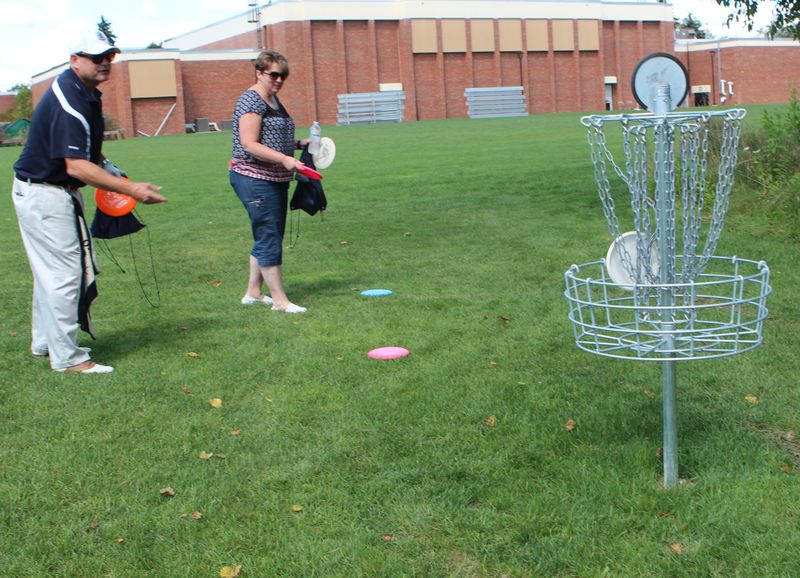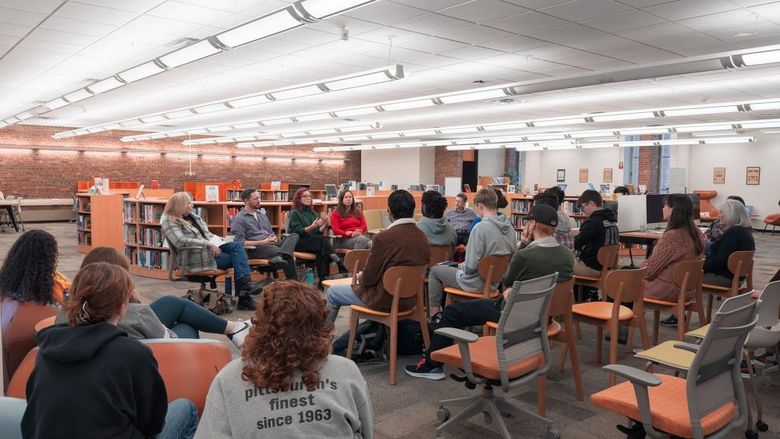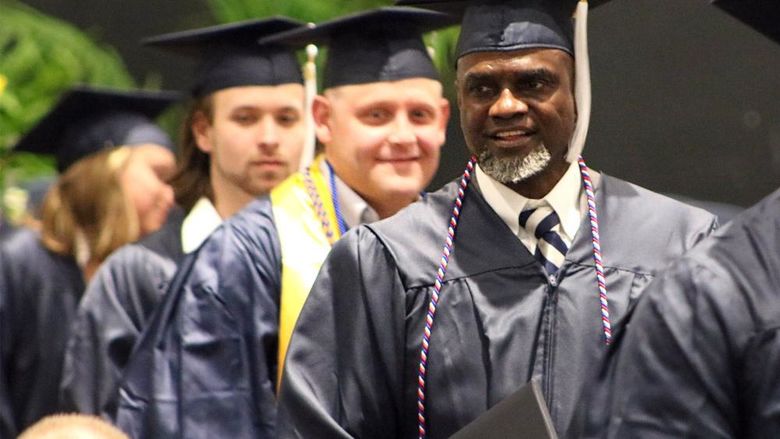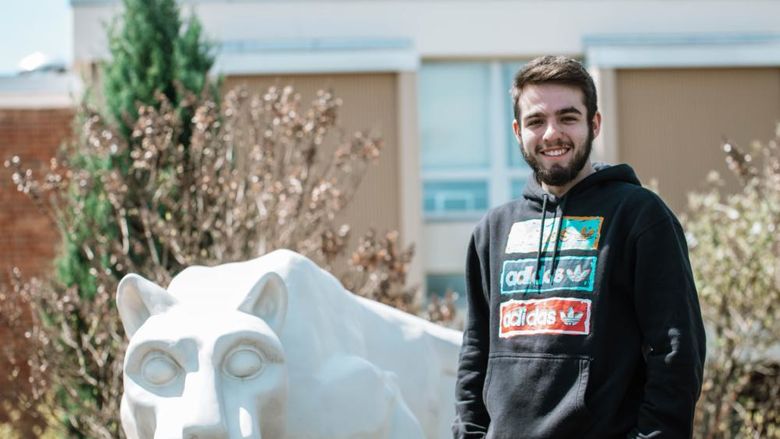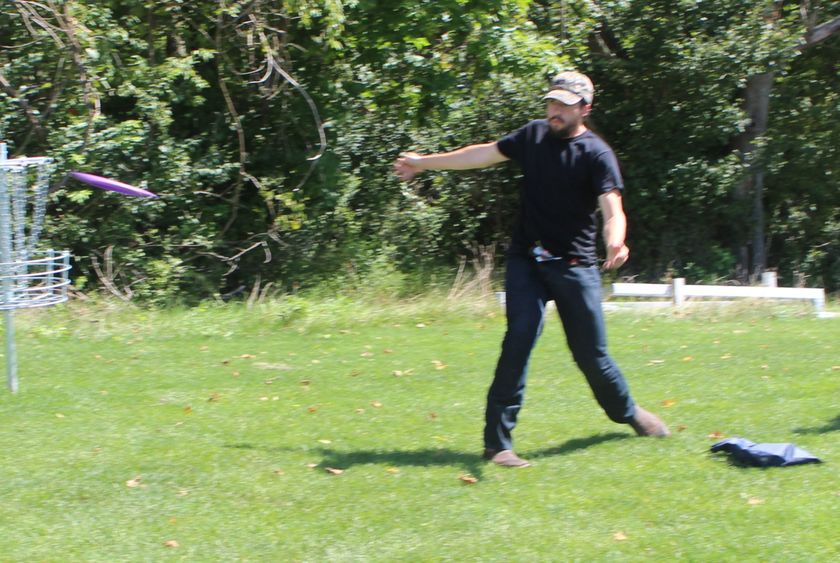
Penn State New Kensington student Cody Shoemaker tees off on the second hole of the new campus disc golf course during the Grand Opening Tournament on Sept. 2
NEW KENSINGTON, Pa. — Although they won’t have their own webcam like their real-life ornithological counterparts in Pittsburgh, birdies and eagles are nesting at Penn State New Kensington with the unveiling Sept. 2 of a nine-hole disc golf course on campus. The layout is open to the public, and there are no green fees.
“We are excited about this new and fun opportunity for students,” said Lauren Blum, assistant director of student affairs. “We will be able to provide some outdoor activities, hosting tournaments and challenges throughout the course.”
Disc golf follows the format of traditional golf but is played with a flying disc or Frisbee instead of balls and clubs. The object is to throw the disc into an elevated metal basket in the least amount of attempts or strokes. Players traverse a nine- or 18-hole layout where holes measure between 200-250 feet on average. Longer par 4s can stretch to 300 or more feet and shorter par 3s can measure 150 feet. Trees, shrubs and terrain changes located in and around the fairways provide obstacles and penalties for golfers.
The campus course is a challenging nine-hole layout that starts behind the Athletics Center, where the multi-purpose field serves as the first hole. This signature hole, longest on the course, is a 336-foot slight dogleg with an elevated tee and trees lining the left side. The rest of the tract winds through the back of campus and finishes below the back parking lot, across the street from the student apartments. For the campus “old timers,” the basket for the ninth hole is located in the backyard of the former Hoy House. With the campus’ natural topography, disc golfers will experience the layout’s beautiful flora and fauna, as well as its beastly hazards and risks.
“The students have been practicing, getting ready for the tournament, and just enjoying the great scenery our campus has to offer,” Blum said. “The winding course is a little challenging, but it’s a great starter course for anyone looking to get into disc golf.”
Constructing a new course on the New Kensington campus was the brainchild of the campus’ activities board, a student organization that assists the Student Life Office in planning campus events and activities. The board recognized that the fitness boom is trending upward and an increasing number of people are participating in recreational activities in an effort to improve health and quality of life. Disc golf is the perfect complement to the campus’ fitness center and yoga and dance rooms.
According to the Professional Disc Gofers Association website, “Disc golf provides upper and lower body conditioning, aerobic exercise, and promotes a combination of physical and mental abilities that allow very little risk of physical injury. Concentration skills increase by mastering shots and negotiating obstacles.”
The game is open to players of all skill and fitness levels. A round takes about an hour and there is no expense, save for buying the disc, which cost less than $15. For basic play, one disc is sufficient. For students, faculty and staff, sets of discs — drive, approach and putter for left- and right-handers — are available for free at the Athletics Center. Caddies are not provided. Lost discs will cost $10. Free discs are not available to the general public.
For more information, contact Blum at 724-334-6063 or [email protected].
Rules of disc golf
Objective of the game
Disc golf is played like traditional “ball” golf, but with flying discs instead of balls and clubs. One point (stroke) is counted each time the disc is thrown and when a penalty is incurred. The goal is to play each hole in the fewest strokes possible. The player with the lowest total strokes for the entire course wins.
Safety first
Never throw when players or park users are within range. Always give park users the right of way. Be aware of your surroundings and environment.
Tee throws
Each hole begins with a tee throw. Tee throws must be completed within or behind the designated tee area.
Lie
The lie is the spot where the player’s previous throw has landed. Mark lie with a mini disc or turn over the thrown disc, directly toward the hole or designated fairway. The player’s subsequent throw is made from directly behind the marked lie.
Throwing order
The player with the least amount of strokes on the previous hole is the first to tee off on the next hole. After teeing off, the player whose disc is farthest from the hole always throws first.
Fairway throws
Fairway throws must be made from directly behind the lie. A run-up and normal follow-through, after release, is allowed, unless the lie is within 10 meters of the target. Any shot within 10 meters of the target requires that the player not move past the lie until the disc is at rest.
Dogleg (or mandatory)
A dogleg is one or more designated trees or poles in the fairway that must be passed as indicated by arrows. Until the dogleg is passed the closest foot to the dogleg must be on the lie when the disc is released.
Completion of hole
A disc that comes to rest in the Disc Pole Hole basket or chains constitutes successful completion of that hole.
Unplayable lie
Any disc that comes to rest above the ground is considered an unplayable lie. The disc must be thrown from the lie on the ground, directly underneath the unplayable lie, relocated to avoid damage to the vegetation.
Out of bounds
If any area of O.B. is visible between the disc and O.B. line, then the disc is considered O.B. A throw that lands out of bounds, must be played from a point 3 feet in bounds from where the disc went out of bounds. Permanent water hazards and public roads are always out of bounds.
Penalties
Recreational players will not be penalized for rule infractions. Other players will keep you honest.
Course courtesy
· Remain quiet and avoid unnecessary movements while others are throwing.
· Stand behind the player who is throwing until throw is complete.
· Remove disc from Disc Pole Hole after completing the hole.
· Help new players learn the rules.
· Allow faster groups to play through when possible.
· Pick up trash and put in proper receptacles.
· Do not alter the course (trees, bushes, etc.) in any way.
Bill Woodard
Alumni and Public Relations Specialist
